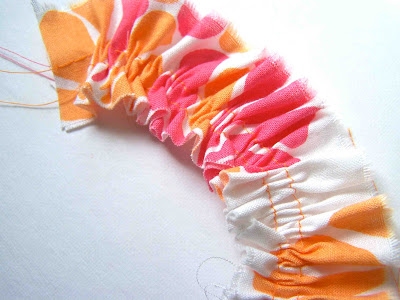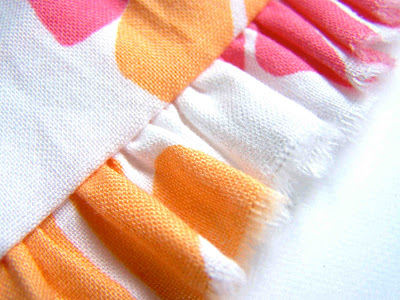Gathers and ruffles are often used in feminine garments. Waistlines, cuffs, necklines, yokes, and sleeve caps, often feature gathered material. Gathering material really is a simple technique, but to a beginning sew-er it can seem a bit daunting. We're going to go over the basics of creating gathers or ruffles with both a basic sewing machine, with a ruffler foot, and an overcast serger.
Any machine that can have thread tension adjusted, and stitch lengthened is capable of creating a gathering row. To start off, you will want to adjust your thread tension so that it is looser that your standard tension. On my machine, I loosen the thread tension by decreasing the number on my tension dial. You will want to refer to your sewing machine manual (if you don't already know) to find out how to adjust your thread tension. My machine is usually set to 4, but for creating gathering rows, I bump it down to 2.
You will also want to adjust the length of your stitch. Typically mine is set at 2.5. The longer your stitch, the easier that it will be to gather the fabric, but the harder it will be to adjust the gathers. I typically set my machine between 3.5 and 4.5 for a medium weight fabric. In this case, I adjusted it to a 5.0 to show the exaggerated stitch length. If you are gathering a light weight or sheer fabric, it is good to use a stitch length that is a bit longer (between 8-10 stitches per inch).
When you creating gathering rows, you will want your stitching lines to fall inside the seam allowance. By doing so any gathering stitches will hidden in the finished seam. You will want to sew two separate gathering rows. Stitching two rows will give you more ability to control your gathers, and make your gathering rows more secure. Should you break one of the two threads while gathering the fabric, you won't have to start all over.
So, assuming that you have a 5/8" seam allowance, you can create your first gathering row 1/4" from the raw edge. You will want to leave your tail threads long (on both ends), and you WILL NOT BACKSTITCH to begin and end your stitching line.
You will create a second gathering row, just as you did the first, but 1/4" away from the first gathering row.
By leaving the ends long, and unsecured, you can pull the bobbin thread to gather the fabric along the length of the thread. To do so, hold the bobbin (pink) threads in one hand, and with the other hand push the material in the opposite direction. The amount of gather depends on how much you pull your threads. You will want to try to evenly distribute your material along the length of the thread.
If you were to add your ruffle or gathered material to another pattern piece, you would match up any pattern markings, pin right sides together, and make sure that your gathers are evenly distributed.
For your 5/8" seam allowance, you'd stitch (with stitch settings reset) 1/8" away from your stitching line. As the fabric gathers, the gathering rows may seem uneven. Try to align the raw edge of your material with your presser foot markings to ensure a straight seam. It is difficult to keep a straight seam if you are using your gathering rows as a guide.
Nice little gathered ruffle.
Obviously this isn't the only way to create a gather, but it is the one that I use most often. Sometimes I get lazy and sew one gathering row, but more than once I've broken my thread while gathering.
Happy Together, shares her favorite approach to gathering material .
Ruffler Foot
There's a nifty little tool that makes gathering material and ruffling fabric much easier. It's a specialty presser foot, or a ruffler foot. Ruffler feet are available for most any machine make and model. I don't happen to have one, but they make gathering material faster and easier. I don't have one for my machine, but if you are working on a project that requires yards and yards of ruffles, then I'd seriously consider investing in one. I recently talked to a friend that has a ruffler foot for her machine, and she was saying that she loves it so much that she's making ruffles for everything. She's even making a quilt with ruffled strips between her quilt blocks.
So, since I don't have one, I'll be directing you to a fantastic video by SewEtcetera. It's really informative, and covers both the anatomy of the presser foot, how to use it, and how to adjust it to meet your needs.
Creating Soft Gathers With A Serger
Another really helpful tool for creating gathers or ruffles is the serger. I love my serger. It is a really basic and inexpensive model (brother 1034d), but it does what I need it to do (for the most part). So I'll share my serger settings to explain how to create a gathered piece of material.
First of all is the machine set up. To create soft gathers, you are going to set up your machine for four threads. You will have your left needle set to five, your right needle set to five, and both your upper and lower looper set to four. Those are the standard tension settings for creating gathers. My machine's tension is a bit off. I left my settings standard, but really should have adjusted them a bit more as my stitches weren't balanced. So, adjust as needed for balanced stitches, but those settings give you a starting point.
Differential: 2.0
Stitch Length: 4.0
Knife: 5.0
Removable Stitching Finger: In Place
So the differential settings are what really make the material gather. When the differential is set to two, the front feed dog is taking in the material two times as fast as the rear feed dog is taking it up. So, the difference in feeding rate, cause the material to gather as it is stitched. Basically, if you're differential is set above 1.0, some slight gathering will occur, the higher the differential, the greater the gathering.
 |
| Standard serger presser foot |
With our machine set, you can feed the material through the machine, and the fabric will gather. My machine refers to these as soft gathers, and that is a pretty appropriate term for the gathering that happens on medium weight fabric. There are light ruffles, but nothing crazy.
Different weights of materials will gather different amounts. Lightweight and sheer materials tend to gather much more.
If working with lightweight material, it is recommended to adjust your presser foot pressure to light to moderate.
Here's a look at some lightweight polyester that I had in my stash, it really gathered up as I fed it through the machine.
Soft gathering is a really easy way to make ruffles for your sewing projects, and best of all, all of those raw edges are nice and tidy.
Serging With A Gathering Foot
Your machine will use the very same settings as it did to create soft gathers. You will place the piece of material that you want to be gathered on the bottom, beneath the foot, with right side up.
You will place the adjoining piece right side down, on top of the fabric separator.
 |
| A look at the separator at work. |
The seam will be formed as the fabric is fed through the machine. The bottom layer will gather, and the top layer will remain flat. Keep in mind that you will need more material on your gathered layer, then on your straight layer.





















6 comments:
Thank you so much for posting this! I have the same serger and haven't taken the time yet to figure out gathering with it. I'm so glad you showed how!
Wow! Great post and clear examples! I like to try making ruffles by adjusting my tension first, but it only works with really lightweight fabrics. Even if it doesn't work completely, it makes the gathering process easier. :)
Great tutorial. I have a question. I am making a dress and would like a gathered bodice. Do you have any suggestions as to how much fabric to add?
Hi! I have the same serger as you, but I'm having a ton of problems with it. It was sitting in my closet for the better part of a year, because I just couldn't get it to work--I thought it was user error, but now I'm not so sure.
I just went to a sewing machine shop, and they think there's something wrong with the timing of my machine. Do you have any problems with a 2 or 3-thread rolled hem, or do you have any problems with the knife cutting too much fabric off?
Thank you I just bought a brother serger/orverlocker and had no idea I could do this.
If I want to hem the fabric to be ruffled, do I do that before gathering?
Post a Comment